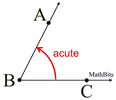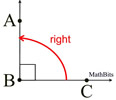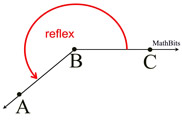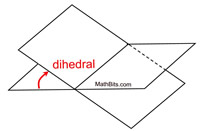|
You have worked with various types of angles in past courses.
Let's refresh and enhance some basic facts we know to be true about angles.
We know that "point" and "line" are undefined terms in geometry.
The word "ray", however, is a defined term using the words "point" and "line",
|
A ray is part of a line with a single endpoint (or point of origin) that extends indefinitely in one direction.
|
|
 |
Notation: |
 |
Notice that the notation for a ray follows the direction in relation to the points A and B.
|
An angle is formed by the intersection of two rays (called the sides) with a common endpoint (called the vertex).
|
|
• An angle is named using three letters, where the middle letter corresponds to the vertex of the angle. The angle at the right may be referred to as ∠ABC or ∠CBA.
• If it is perfectly clear which angle is being named, an angle may be referred to by its vertex letter alone, such as, in this case, ∠B.
(See more about naming angles.)
|
 |
An angle is measured in degrees. A protractor is a tool for working with angles and degrees. If you need a refresher on using a protractor, refer to "Using a Protractor".
|
An acute angle is an angle whose measure is less than 90º.
|
|
A right angle is an angle whose measure is 90º.
|
|
An obtuse angle is an angle whose measure is greater than 90º but less than 180º. |
|
A straight angle is an angle whose measure is 180º. |
|
A reflex angle is an angle whose measure is greater than 180º but less than 360º
If an angle is a reflex angle, it will be clearly indicated by a drawing or by a reference in the wording of the problem. |
|
An oblique angle is any angle that is not 90º, not a right angle.
|
Oblique angle
= NOT a Right Angle. |
|
A dihedral angle is an angle between two planes. |
|



NOTE: The re-posting of materials (in part or whole) from this site to the Internet
is copyright violation
and is not considered "fair use" for educators. Please read the "Terms of Use". |
|








